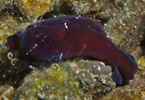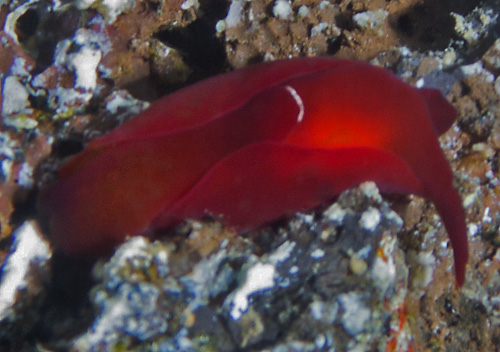| Home |
| Acknowledgments |
| Conventions |
| Glossary |
| Maps |
| References |
| Links |
| Articles |
| Thumbnails |
| Species
list |
| Family |
| Next
species |
Additional Photos

color change

4th animal

Chelidonura(?) sp. #6

| Maximum size: about 10 mm. Identification: This is a small, red-orange to violet-black animal with a narrow white band on the posterior margin of its head shield. The "tails" are highly asymmetric with the left elongate and the right truncate. Natural history: Chelidonura(?) sp. #6 is known from four animals. The first three were found in a large tide pool at a depth of < 1 m (about 2 ft). (Note 1) A fourth animal was found in a Halimeda kanaloana bed at about 12 m (40 ft). Like other Chelidonura spp., it may discharge an orange fluid when disturbed. It can change color from red-orange to violet-black and may prove to be primarily nocturnal. (Note 2) (Note 3) Distribution: Big Island. may be known from the western Pacific? (based on on-line photos). Taxonomic notes: It was probably first recorded in Hawaii from Kapoho tide pools, Big Island by Ralph Turre on Nov. 29, 2017. However, there's some chance that it might ultimately turn out to be a live Chelidonura(?) sp #3. Given it's color and possible nocturnal habits, there's some question whether this species is a Chelidonura or a Biuve. There's also some possibility that it's the mature form of Chelidonura(?) sp. #5. Photo: Ralph Turre: about 6-9 mm: Kapoho tide pools, Big Island; Nov. 29, 2017. Observations and comments: Note 1: Ralph Turre reported that they were found in a large pool up to 3.6 m (12 ft) in depth that was located about 91 m (300 yards) from the ocean breakwater and about 30 m (100 yards) from an area where rainwater flows into the pool. They were found under a rock on a "shallow gravel slope near the crest of a ledge with a small amount of larger rock debris." The area showed signs of freshwater influx when they were found although he reported the presence of other typically marine species (including Chelidonura hirundinina) in the immediate vicinity suggesting that its impact is probably transient. Note 2: Ralph Turre reported that all three animals were red-orange when first observed but that two changed color when disturbed. He stated that: "The transition of one animal was almost immediate, began in the area of the head and extended rapidly through the entire body. Another one also began to turn purple but then returned to its original color." In addition, he observed one animal discharging orange fluid. Note 3: Pam Madden took videos of an animal crawling actively, at night in a small Halimeda kanaloana bed. |
| Thumbnails |
Species
list |
Family | Next species | Top |